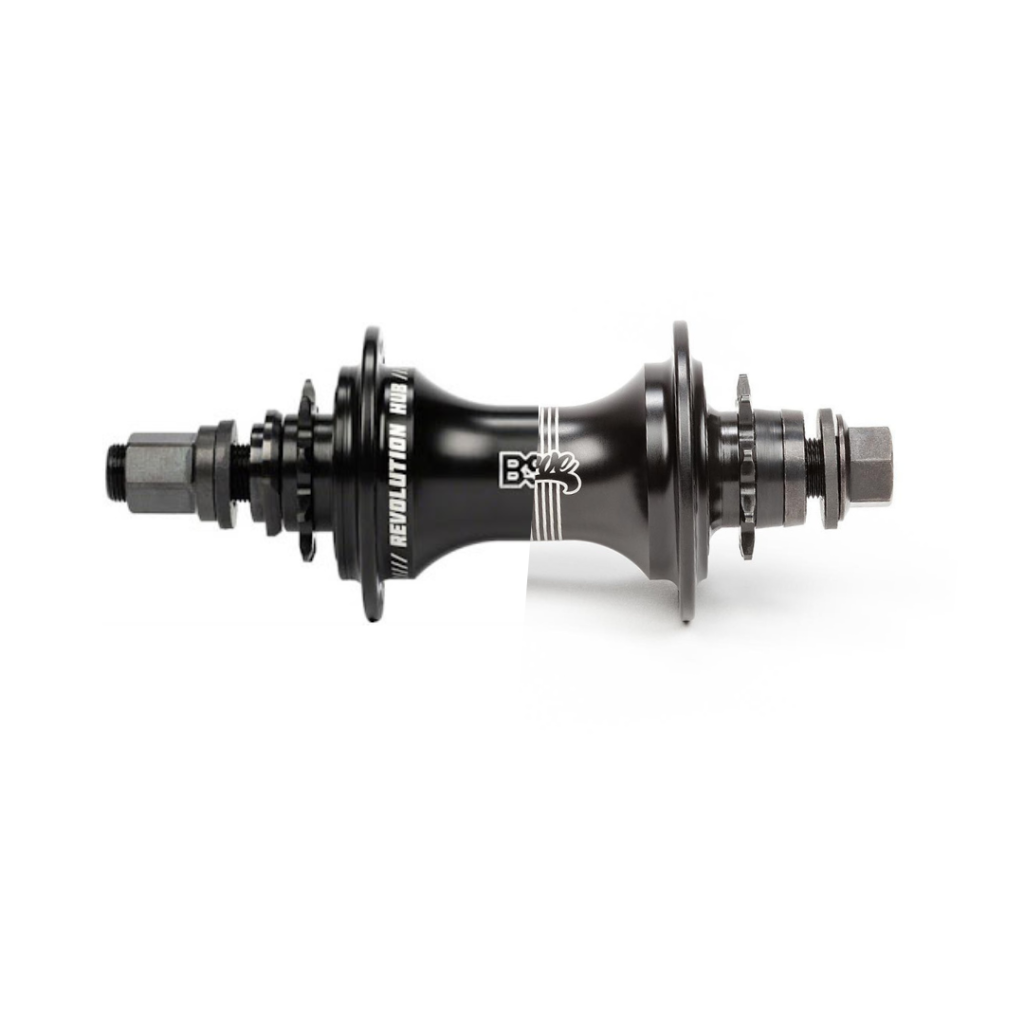If you want to ride a BMX, you’ll need some way to power your wheel to give you forward movement. Thankfully, the rear wheel was invented ages ago, and we have a great choice of rear wheels; there is, though, a stumbling block for some people, and that is what is the difference between a freecoaster and a cassette, the dubbed rear wheel. Thankfully, we’re about to explore that issue.
BMX Cassette Hub

1. Engagement Mechanism
- Pawls and Ratchet System: Cassette hubs utilise a pawl and ratchet system for engagement. The hub has multiple spring-loaded pawls that engage with corresponding teeth on the hub’s shell, allowing the rider to pedal forward.
2. Pedalling
- Instant Engagement: One of the primary advantages of cassette hubs is their instant engagement. When the rider starts pedalling, there is no delay in power transfer as the pawls engage immediately, providing a direct and responsive connection between the pedals and the rear wheel.
3. Backpedalling
- No Freewheeling: Cassette hubs do not allow for freewheeling or backpedalling without engaging the drive train. This characteristic can be advantageous for certain BMX riding styles, especially when precise control over pedalling is required.
4. Maintenance
- Simplicity: Cassette hubs are relatively simple in design, often resulting in easier maintenance. The pawls and springs are accessible, making it straightforward to clean and lubricate the engagement mechanism.
5. Riding Style
- Responsive Riding: Riders who prefer a responsive and direct connection between pedalling input and wheel movement often opt for cassette hubs. This makes them suitable for technical and precise manoeuvres.
6. Weight
- Lighter: Generally, cassette hubs are lighter than freecoaster hubs due to their simpler construction and fewer internal components.
7. Cost
- Affordability: Cassette hubs tend to be more affordable than freecoaster hubs, making them a popular choice for riders on a budget.
Freecoaster Hub

1. Engagement Mechanism
- Clutch System: Freecoaster hubs use a clutch mechanism instead of pawls and ratchets. This allows the hub to disengage when coasting backwards, providing a “free coasting” experience.
2. Pedaling
- Coasting Backward: The main feature of a freecoaster hub is the ability to coast backwards without pedalling. This is advantageous for certain BMX tricks and styles where riding backwards is a crucial element.
3. Backpedaling
- Freewheeling: Unlike cassette hubs, freecoaster hubs allows the rider to freewheel or coast backward without engaging the drivetrain. This feature is particularly beneficial for riders who focus on flatland or certain street tricks.
4. Maintenance
- Complexity: Freecoaster hubs are generally more complex internally due to the clutch system. This complexity can make maintenance a bit more involved compared to cassette hubs.
5. Riding Style
- Flatland and Street Riding: Freecoaster hubs are often favoured by flatland riders and those who specialise in certain street riding styles. The ability to coast backwards seamlessly opens up new possibilities for creative tricks.
6. Weight
- Heavier: Freecoaster hubs tend to be heavier than cassette hubs due to the additional components required for the clutch mechanism.
7. Cost
- Higher Price: Freecoaster hubs are generally more expensive than cassette hubs. The added complexity and unique features contribute to the higher price point.
Choosing Between Cassette and Freecoaster Hubs:
1. Riding Preference
- Consider Your Style: Your preferred BMX riding style significantly influences the choice between a cassette and a freecoaster hub. A cassette hub may be more suitable if you enjoy trails, park riding, and responsiveness. On the other hand, if you ride flatland or street, a freecoaster hub might be the better choice.
2. Skill Level
- Beginners vs. Advanced Riders: Beginners may find cassette hubs more intuitive due to their immediate engagement and direct power transfer. Advanced riders who have mastered the basics may explore the creative possibilities offered by a freecoaster hub.
3. Trick Requirements
- Trick-Oriented Riding: Consider the specific tricks you want to perform. If your style involves a lot of backward riding or fakie tricks, a freecoaster hub’s ability to coast backwards without pedalling may be crucial.
4. Weight Concerns
- Weight Considerations: If weight is a significant concern, a cassette hub’s lighter weight might be more appealing.
5. Budget
- Financial Considerations: Your budget also plays a role in the decision-making process. Cassette hubs are generally more budget-friendly, making them a practical choice for riders on a tighter budget.
6. Maintenance Comfort
- Maintenance Skills: Consider your comfort and skill level with hub maintenance. Cassette hubs are often more straightforward to maintain, while freecoaster hubs may require more attention to the clutch mechanism.
Conclusion:
In summary, choosing between a BMX cassette hub and a freecoaster hub boils down to personal preference, riding style, skill level, and specific trick requirements. Both types of hubs have advantages and disadvantages, and what works best for one rider may not be suitable for another.
Cassette hubs offer instant engagement, responsiveness, simplicity, and affordability, making them a popular choice for riders prioritising these features. They are well-suited for technical street riding and park manoeuvres.
Freecoaster hubs, on the other hand, provide the unique ability to coast backwards without pedalling, opening up new possibilities for specific tricks and styles. They are favoured by flatland riders and those who enjoy specific street riding techniques that involve backward movement.
Ultimately, riders should experiment with both types of hubs to determine which aligns better with their riding preferences and goals. Additionally, seeking advice from experienced riders, trying out different brands, and considering individual riding aspirations can help make an informed decision between a BMX cassette hub and a freecoaster hub.

Leave a Reply